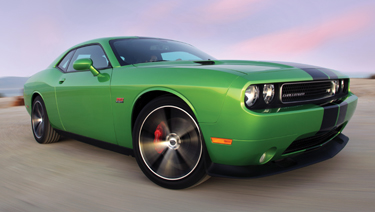 The 2005-current Chrysler rear-wheel-drive LX-Platform. The LX platform includes the 300, Magnum and Charger. In 2008, the platform was shortened for use in the LC-platform that was used in the Challenger platform. All have rear disc brakes with the parking/emergency brake mounted in the hat of the rear rotor.
The 2005-current Chrysler rear-wheel-drive LX-Platform. The LX platform includes the 300, Magnum and Charger. In 2008, the platform was shortened for use in the LC-platform that was used in the Challenger platform. All have rear disc brakes with the parking/emergency brake mounted in the hat of the rear rotor.
Calipers
All calipers, except the SRT version with Brembo brakes, are equipped with phenolic pistons. These help to reduce noise and reduce the transfer of heat to the brake fluid.
Some reports have surfaced of rebuilders using steel pistons for replacement calipers instead of phenolic pistons. The use of steel pistons can cause problems with brake fade and noise. This brake system was designed to use phenolic pistons. Be careful when pushing the piston back. Chrysler advises that no tools should come in contact with the pistons. They even specify that a piece of wood should be used.
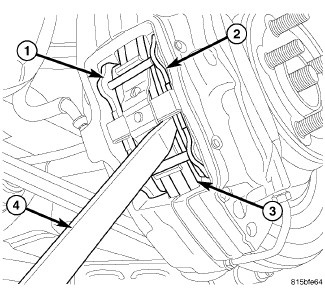 Most of the calipers on LX-platform are cast aluminum. Technicians should be careful removing hardware due to galvanic corrosion. Be careful when installing new banjo bolts in order to prevent stripping. The front caliper bolts may look large and beefy, but they have a low torque spec of 44 ft/lbs. In the rear, it is 23 ft/lbs!
Most of the calipers on LX-platform are cast aluminum. Technicians should be careful removing hardware due to galvanic corrosion. Be careful when installing new banjo bolts in order to prevent stripping. The front caliper bolts may look large and beefy, but they have a low torque spec of 44 ft/lbs. In the rear, it is 23 ft/lbs!
Brake Packages
If the vehicle has the 2.7 or 3.5 V6, the majority of the time it will have single-piston floating front calipers. V8 models will have dual-piston front calipers. In the rear, upgraded models have larger vented rotors and different calipers. Also, all all-wheel-drive models receive the upgraded brakes. R/T 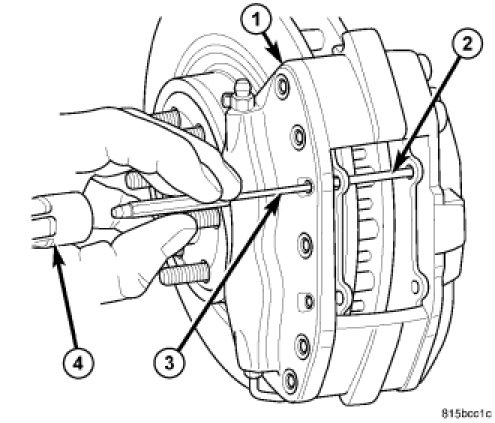 models are equipped with four-piston Brembo calipers and rotors.
models are equipped with four-piston Brembo calipers and rotors.
On R/T and SRT models, if the system senses a high G-force maneuver that might cause the hub units to flex and knock the pistons back, the system will send pressure to the caliper to push the pads back into the correct position. This is designed to prevent a long pedal on the next stop. Looking over the torque specs for the LX platform, one thing that sticks out is the wheel torque of 110 ft.lbs.
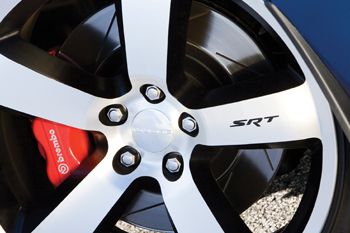 Inspection
Inspection
The biggest complaint from technicians about the LX platform is the difficulty seeing the pads through the inspection holes and edges of the caliper. Chrysler recommends technicians compress the piston enough so that the lower caliper bolt can be removed and the caliper can be rotated upwards.
In the rear, the upper bolt can be removed and the caliper can be swung down.
Why should you go through this trouble? On dual-piston calipers, tapered brake pad wear can indicate problems with the caliper seals or the hardware. Also, it is easier and more profitable to know the calipers need replacement during the estimate process than having to call the customer a second time and waiting for the part.
Chrysler set the total disc thickness variation and runout standards very high for all the brake packages. Disc thickness should not vary more than .0004"(.010mm) and total runout should not exceed 0.0014" (.035mm). These are some of the lowest numbers in the industry, and even forgetting to properly clean the hub’s flange can put a vehicle out of specification.
Only one recall or TSB has been issued for the rear-wheel drive LX platform’s brake system. 45,000 LXs with 2.7 liter were recalled due to a brake line under the hood that was mounted too close to the exhaust gas recirculation valve’s tubing.
Installing New Pads and Rotors
The installation of the new pads and rotors is straightforward. It is recommended that with every pad change the abutment clips be replaced. If the clips do not have the right amount of tension, the retraction of the pistons will not reduce brake drag. This could mean increased gas mileage.
The front brake caliper bracket should be tightened to 70 ft/lbs and the rear should tightened 85 ft/lbs. The caliper bolts have a torque spec of 44 ft/lbs and 23 ft/lbs in the rear.
Base System Bleeding
Pressure bleeding is highly recommended to bleed this brake system to ensure all air is removed from the system. Manual bleeding may also be used, but additional time is needed to remove all air from system. The bleeding pattern goes: right rear, left rear, right front and finish at the left front.
Chrysler advises to open the bleeder screw at least one full turn. Some air may be trapped in the brake lines or valves far upstream — as far as 10 feet or more from the bleeder screw. If the bleeder screw is not opened sufficiently, fluid flow is restricted causing a slow, weak fluid discharge.
ABS Bleeding
Brake systems with ABS must be bled as two independent braking systems. The non-ABS portion of the brake system with ABS is to be bled the same as any non-ABS system. The ABS portion of the brake system must be bled separately.
Use the following procedure to properly bleed the brake hydraulic system including the ABS.
To ensure all air is bled from the ICU or junction block quickly, it is recommended to raise the rear of the vehicle approximately 10-12 inches as measured at the rear bumper.
When bleeding the ABS system, the following bleeding sequence must be followed to ensure complete and adequate bleeding.
Make sure all hydraulic fluid lines are installed and properly torqued.
Connect the scan tool to the diagnostics connector.
Using the scan tool, check to make sure the ABS system does not have any fault codes stored. If it does, clear them.
Bleed the base brake system.
Select the menu for bleeding and follow the procedure. Follow the instructions displayed.
Bleed the base brake system a second time. Check brake fluid level in the reservoir periodically to prevent emptying, causing air to enter the hydraulic system.
Fill the master cylinder fluid reservoir to the MAX level.
Test drive the vehicle.
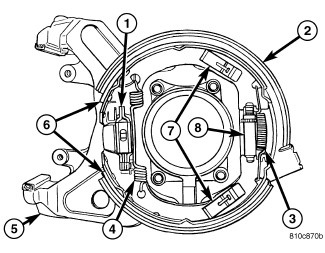 Parking Brake Adjustment
Parking Brake Adjustment
The adjustment of the parking brake is simple and easy to access. Most adjustments can be made at the wheels.
Initial Adjustment
1. Remove rear brake rotor.
2. Using Brake Shoe Gauge, measure inside diameter of the parking brake drum portion of the rotor.
3. Place gauge over parking brake shoes at widest point.
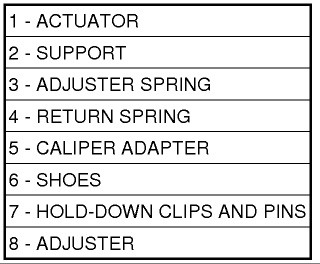
4. Using adjuster star wheel, adjust parking brake shoes until linings on both parking brake shoes just touch jaws on gauge.
5. Install rear brake rotor.
6. Perform fine adjustment of parking brake shoes.
Final Adjustment
1. Place parking brake lever in full released position.
2. Raise and support vehicle.
3. Remove plug in parking brake shoe support to access adjuster star-wheel, rotate the adjuster star wheel in the following direction to expand the shoes outward against the drum. Left brake – Rotate star-wheel toward rear of vehicle. Right brake – Rotate star-wheel toward front of vehicle.
4. Turn adjuster star wheel until wheel will not rotate (dead lock).
5. Back off adjuster six detents (teeth).
6. Rotate wheel, checking for light drag. If drag is too heavy, continue to back off adjuster one detent at a time until light drag is present. Do not back off star-wheel more than 17 detents from wheel lock.
7. Install access plug.
8. Adjust opposite wheel parking brake shoes using same method.
9. Apply and release parking brake lever once to ensure proper operation of parking brakes.







